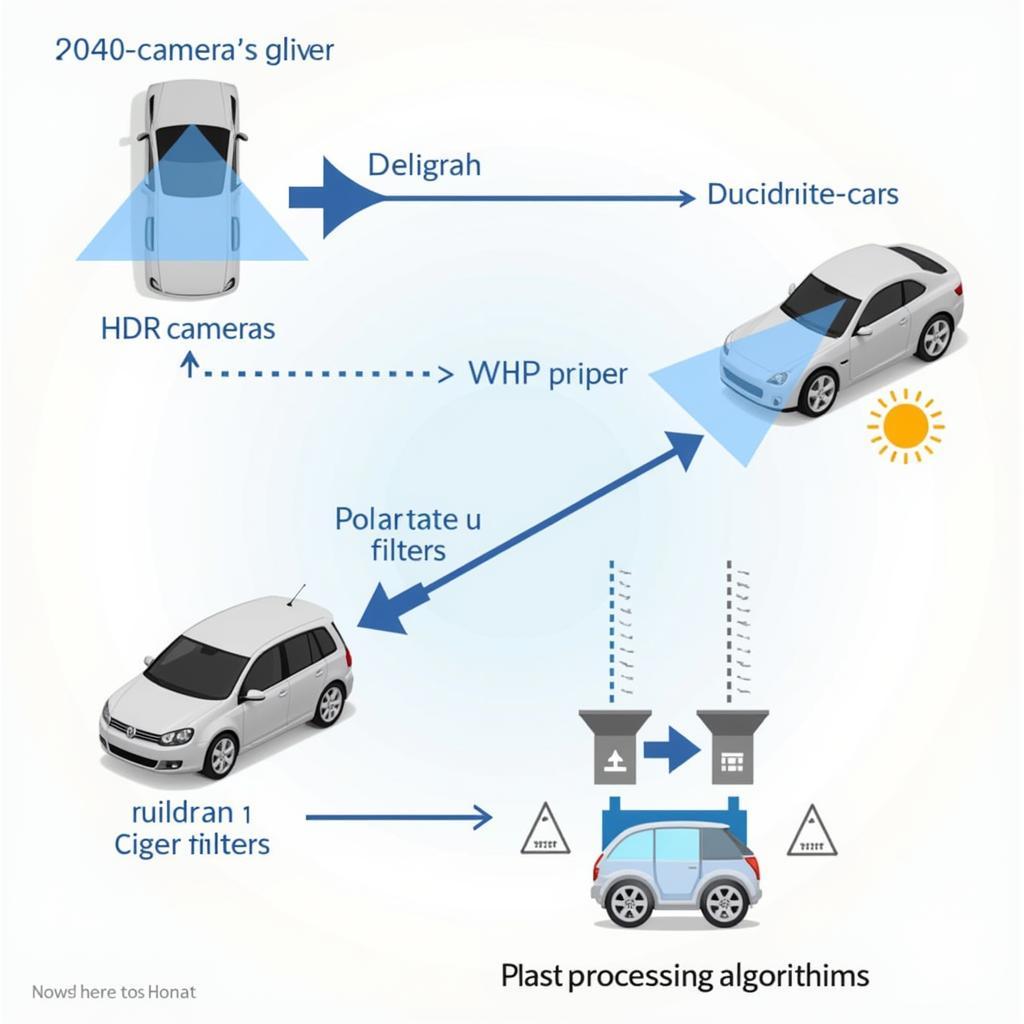Camera glare is a significant self-driving car problem that affects the performance and safety of autonomous vehicles. It interferes with the vehicle’s ability to “see” its surroundings, potentially leading to misinterpretations of the environment and dangerous situations. Understanding this issue and potential solutions is crucial for both owners and technicians working with self-driving technology.
Understanding the Impact of Camera Glare on Self-Driving Cars
Self-driving cars rely heavily on cameras to perceive the world around them. These cameras act as the “eyes” of the vehicle, feeding data to the onboard computer which then makes decisions about navigation and safety. When camera glare occurs, whether from direct sunlight, reflections off wet surfaces, or bright headlights, it can overwhelm the camera sensor, effectively blinding the vehicle. This can lead to:
- Misinterpretation of lane markings: Glare can obscure or distort lane lines, causing the vehicle to deviate from its intended path.
- Failure to detect obstacles: Glare can mask the presence of pedestrians, cyclists, or other vehicles, increasing the risk of collisions.
- Inaccurate distance estimation: The blinding effect of glare can make it difficult for the car to accurately judge distances, impacting braking and maneuvering decisions.
How to Mitigate Camera Glare in Self-Driving Cars
Addressing the camera glare self-driving car problem requires a multi-faceted approach involving both hardware and software solutions. Here are some key strategies:
Hardware Solutions
- High-Dynamic Range (HDR) Cameras: HDR cameras capture a wider range of light intensities, allowing them to better handle bright highlights and dark shadows, reducing the impact of glare.
- Polarizing Filters: These filters can reduce glare by blocking polarized light, such as reflections from water or glass.
- Camera Placement and Design: Strategically positioning cameras and designing camera housings to minimize direct exposure to sunlight can help mitigate glare.
Software Solutions
- Image Processing Algorithms: Sophisticated algorithms can be used to identify and filter out glare in real-time, restoring image clarity.
- Sensor Fusion: Combining data from multiple sensors, such as lidar and radar, can compensate for camera limitations in glare situations.
- Machine Learning: Training AI models to recognize and adapt to different lighting conditions can improve the robustness of self-driving systems in the presence of glare.
 Self-Driving Car Camera Glare Solutions
Self-Driving Car Camera Glare Solutions
“Properly addressing camera glare isn’t just about improving performance; it’s about ensuring the safety of everyone on the road,” says Dr. Emily Carter, a leading expert in autonomous vehicle technology.
What are the Common Causes of Camera Glare in Self-Driving Cars?
The most common causes of camera glare are:
- Direct Sunlight: The most prevalent source, particularly during sunrise and sunset.
- Reflections: From wet roads, other vehicles, or buildings.
- Bright Headlights: Especially from oncoming traffic at night.
Can Camera Glare Completely Disable a Self-Driving Car?
While camera glare can significantly impair a self-driving car’s vision, it’s unlikely to completely disable it. Most systems have redundant sensors and fail-safes to mitigate such issues. However, it can still lead to hazardous situations.
“Redundancy is key,” adds Dr. Carter. “While cameras are vital, relying on multiple sensor types allows the vehicle to continue functioning safely even when one system is compromised.”
In conclusion, camera glare presents a real challenge for self-driving car technology, impacting both performance and safety. However, ongoing advancements in hardware and software solutions are paving the way for more robust and reliable autonomous vehicles. Addressing this self-driving car problem is paramount for the successful integration of this technology into our everyday lives. Connect with us at AutoTipPro for further assistance. Our phone number is +1 (641) 206-8880 and our office is located at 500 N St Mary’s St, San Antonio, TX 78205, United States.
FAQ:
- How does camera glare affect self-driving car safety?
- What are the latest advancements in mitigating camera glare?
- Are there any regulations regarding camera glare in autonomous vehicles?
- How can I report a camera glare issue with my self-driving car?
- What are the future prospects for solving the camera glare problem?
- How does camera glare impact the reliability of autonomous vehicles?
- What are the different types of cameras used in self-driving cars and how are they affected by glare?





Leave a Reply